How do riding professionals aim to stay safe on the roads?
Every biker has their own hot riding tips for better, safer riding on the road, ranging from tricks learned on track days or off-roading, to advice picked up from other riders, from bitter experience, or on BikeSafe days with the police.
But what if you had a direct line into Britain’s most experienced motorcycle professionals? Experts who honed their skills in the saddle, who built up years of hard-won experience on the road – and who have reached the top of their trade?
Now – thanks to Devitt – you have.
We’ve done the work for you and spoken to seven leading riders to find what goes through their minds when they’re riding, to keep them safe and sound.
We asked each to provide tips that aren’t widely known, tips that they rely on, tips that are often forgotten or ignored – and that could transform your riding.
Our panel of experts are some of the best-known in the industry, with skills ranging from the race track, to the lecture hall and classroom, the road, law enforcement – and writing.
Each has shared their top two tips designed to help you become a better, safer rider, almost instantly. Don’t get us wrong; we know that developing a safe riding technique takes years – and that you never stop learning and improving.
Many of you might be familiar with the tips here, already. But do you remember to use them?
Safe, expert riding depends on a wide range of skills – as well as the right attitude – so these tips won’t turn you into a master rider overnight.
Study what our experts say, work out how to incorporate their advice into your own daily riding, put them into practice – and be sure to let us know what difference it has made to your riding, below.
Expert: Kevin Williams
Background: Full-time advanced rider coach at Survival Skills Rider Training. Founded the Science of Being Seen project. Has released a paperback on the subject, delivers talks to riding groups and clubs, and writes about motorcycle safety.
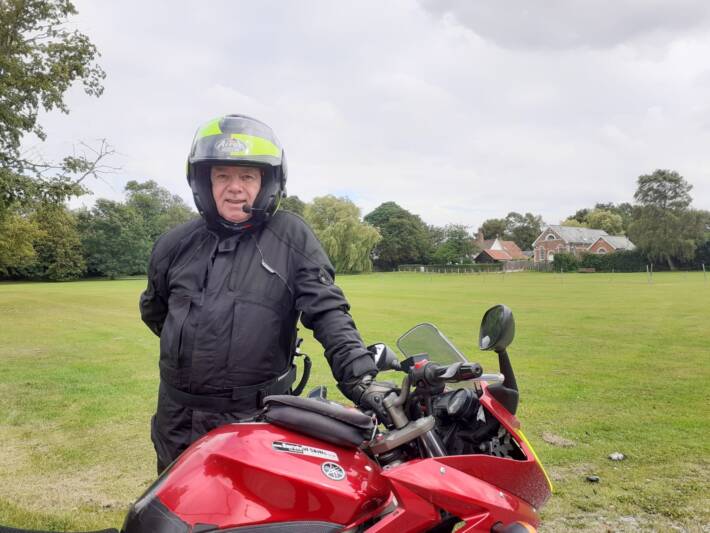
Lifesaving tip 1:
“Anyone who’s done any post test training is likely to have heard of the Limit Point – it’s the furthest we can see along the road, and we should be able to stop ‘well within’ the distance that’s clear.
“But how sharp is the corner itself? So long as you can see the broken hazard line disappearing round the bend, here’s a useful trick – count the number of lines that are visible.
If you can see ten or more, the bend’s easy – you might not need to slow down.
If you can see half-a-dozen, it’s likely you’ll need to roll off and go down a gear. If you can only see two or three, it’s time to get on the brakes and get the speed off. It’s sharp!”
Lifesaving tip 2:
“We all need to be aware of poor surfaces – metal access covers, worn out patches, lumps and bumps, repairs, damp or icy areas and so on, and that they are best avoided, particularly when changing speed or direction.
“But have you ever thought about why high grip anti-skid surfaces are where they are? You’ll often see them on the approach to pedestrian crossings where drivers and riders are braking late and hard.
So if you see them approaching a junction or a bend out on a rural road, assume that vehicles may emerge unexpectedly, or a bend might be sharper than you think.
The implication is that other people have got it wrong at that point and the high grip surface is to help prevent skids.”
Expert: Inspector Colin Reid.
Background: Head of Road Policing and Driver Training, Police Scotland. Advised on the new version of Motorcycle Roadcraft, the Police Rider’s Handbook.
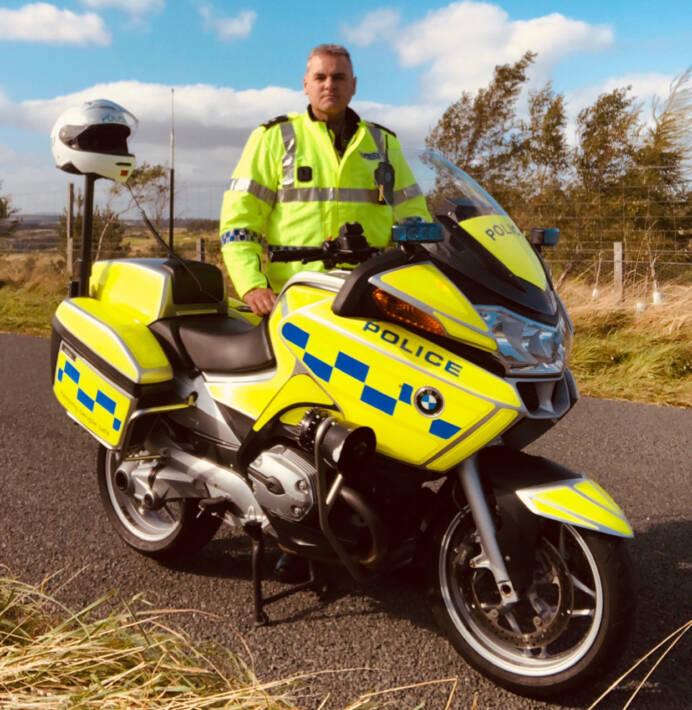
Lifesaving tip 1:
“When positioning for corners, think about positioning for safety but also to help the bike do what it’s designed to do; corner well.
If the road bends left, position more to the right (but consider oncoming traffic). If the road bends right, position more to the left (but watch for nearside danger).
This simple tip to position gives you an early and better view into the bend but it also increases the turning circle which is safer.”
Lifesaving tip 2:
“Look at how much road you have between you and the hazard ahead. If you have less road, reduce your speed. If the road opens up and you see more of it, you can apply more speed (up to the speed limit, of course). Less road = less power. More road = more power.”
Expert: Richard Gladman
Background: IAM RoadSmart’s Head of Driving & Riding Standards. Career police officer with specialisms in accident investigation and driver and rider training. Passionate about riding – with a smile on your face.
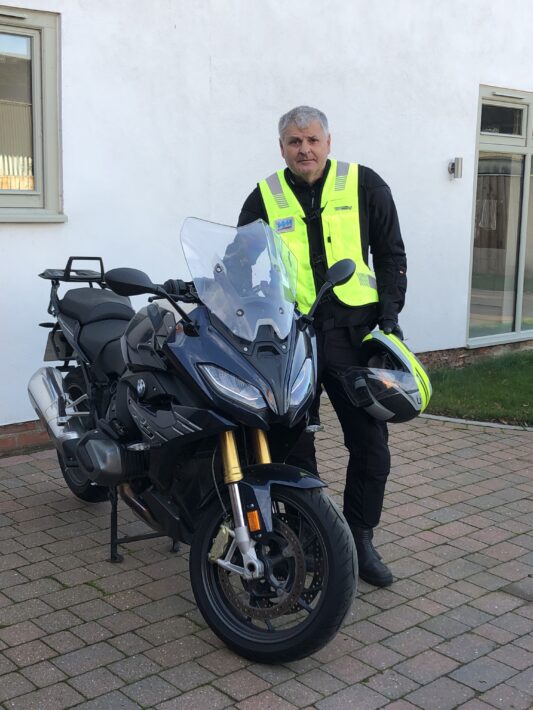
Lifesaving tip 1:
“Ride each road as if you are riding it for the first time. It will make you think, and a thinking rider is what we are aiming for.
Do not use ‘always’ or ‘never’ when assessing your own ride – each decision should be relevant to the information you are taking in, not relevant to what you knew yesterday.”
Lifesaving tip 2:
“When does filtering become overtaking dangerously? Filtering is mentioned in the Highway Code, cautioning car drivers to watch out for it, and motorcyclists to take care when doing it. Keep your speed differential in relation to the traffic that you are in, low (no more than 10mph).
Don’t continue filtering when the traffic is moving at more than a very slow pace (20mph). Just because your motorcycle fits doesn’t mean you want to put it there.”
Expert: Mike Abbott
Background: Mike is a time-served automotive engineer with Ford, and served his apprenticeship at Dagenham, AVO and Boreham, and spent many years working in Automotive.
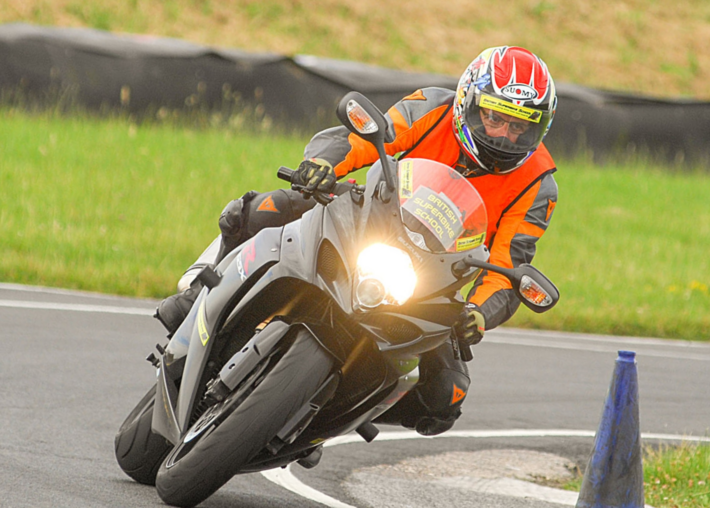
He passed his bike test in 1967 and started road racing rather late in 1989 on a Yamaha TZ350H, finishing 4th in his first year, getting the FRC (Forgotten Racing Club) ‘Novice of the Season’ cup – at 38 years old – retiring from racing in 2005. Mike got the ‘Bridemaid’s Trophy ‘in 1994 having come consistently close but never winning a championship.
He qualified as a RoSPA Advanced Motorcycle Instructor in 2009, and a DVSA Post-test Trainer in 2010. Helaunched the Superbike School with much help from friends in 2011, and in 2015 qualified as an ACU Road Race Coach with ‘The School’ subsequently accredited by the ACU as ‘excellent’.
Lifesaving tip 1:
“Practise emergency braking. Find somewhere safe, away from traffic. Use both brakes, gently squeeze the front initially – don’t snatch, then once the front of the bike sinks as the weight has been transferred forward, you can squeeze as hard as you like even without ABS – even on a wet road you can get the rear wheel in the air.
If the ABS comes on you’ve done it wrong (unless you have a tilt sensor when it will come on as the rear wheel lifts). You need to gradually release the rear brake if you can remember to do this (not vital) to stop the rear wheel locking. Braking follows a square law. Twice the speed = 4 x the stopping distance.”
Lifesaving tip 2:
“Use the ‘limit’ or ‘vanishing’ point when cornering – and look where you want to go, not where you don’t. Scan ahead for potholes etc. and use your peripheral vision closer up.
Given a fairly decent road surface you can lean a bike until something scrapes, and then a bit if you lean off, so look around the corner and simply hang on – it’s panic that causes the vast majority of collisions on bends.
Mid corner – use the rear brake – not the front – far safer. Practise rear braking gently when banked – with care.
You can actually trail-brake quite hard into corners with front and/or rear (racers do it all the time) – but applying the front brake for the first time mid corner will likely result in a fall, as much of the weight isn’t on the front tyre, and you’ll have to wrestle the steering as the wheels will try to line themselves up.
Trailing it in keeps the weight on the front, but you have to gradually release the brakes as your lean angle increases. It’s not sensible on the road unless in an emergency.”
Expert: Tom Killeen
Background: Founder and owner of i2i Motorcycle Academy, that specialises in changing behaviour – and ‘putting the fun into riding bikes’.
Tom is also certified IAM, ROSPA and BMF advanced rider and tutor. He’s trained police, collision investigation officers, off-road at all levels, Supermoto at all levels and track and road at all levels.
He calls on statistics for collisions and fatalities in the UK to inform key areas on which to focus training. He focuses on why some riders feel anxious.
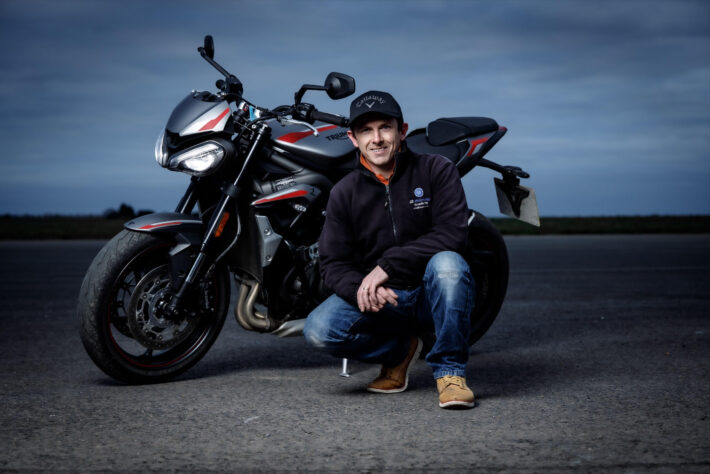
Lifesaving tip 1:
“Learn to lean the bike quicker. Most riders lean slowly causing them to run wide if they don’t slow down a lot, which is not needed if they just lean quicker. Use more pressure while applying steering inputs (counter steer) which will achieve a faster lean rate.”
Lifesaving tip 2:
“Steering should be applied with both hands, making sure the push and the pull is consistent with the direction the bars go, not downwards which can make the bike feel and react slowly, hence why most riders take a long time to move a bike from 30° lean in one direction to 30° in the other direction.”
Expert: Mark Jaffe
Background: Mark has been running Phoenix Motorcycle Training – which has 17 locations across the south of England – since 2010. It is the largest provider of motorcycle training in the UK.
He is the chief motorcycle examiner for the DIA (Driving Instructors Association) as well as being on a number of steering committees with the DVSA, DfT, and the Motorcycle Industry Association.
He works closely with the behavioural change teams at Transport for London. He is an IAM RoadSmart examiner and a National Observer assessor.
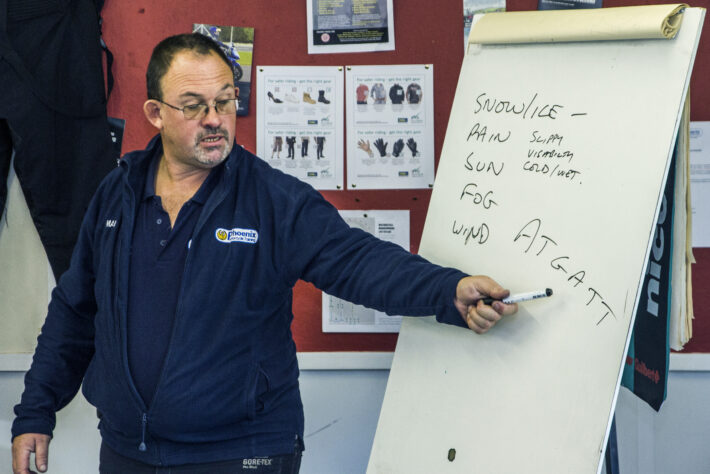
Lifesaving tip 1:
“A crash can only occur when two vehicles are in the same space at the same time. As long as you plan not to be in the same space at the same time as another vehicle, you won’t be involved in a crash.”
Lifesaving tip 2:
“COAST – Concentrate – Observe – Anticipate. This will give you SPACE and TIME.”
Expert: Steph Jeavons
Background: Steph is an author, journalist and adventurer who, in April 2018, completed a solo around-the-world trip that took her to all seven continents.
She logged 53 countries and over 74,000 miles, over nearly four years, on a 250cc Honda named Rhonda. In 2018 Steph led the first group of all women bikers to Everest Base Camp in Tibet.
She now focuses on her company Moto Junkies, which offers the best of Wales and beyond on two-wheels through off and on-road training, tours and adventures.
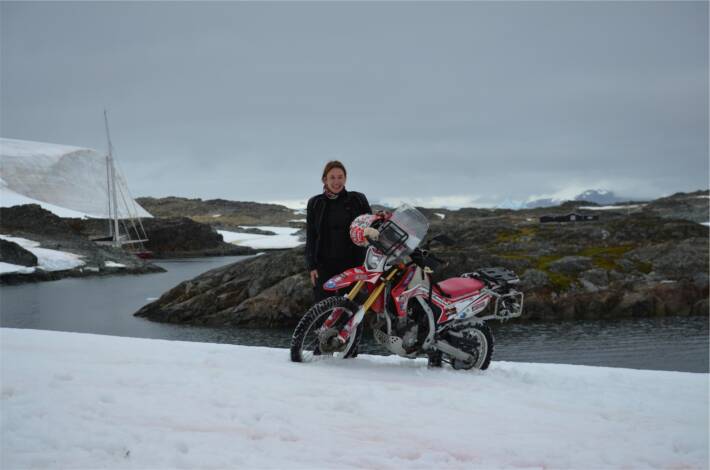
Lifesaving tip 1:
“When riding abroad, take time to find the method in the madness. It‘s often there, once you get into the flow. Riding as you would at home, or assuming you know how traffic will behave, is not always wise. Watch, learn, and adapt your style.
Some countries indicate to tell you it’s safe to overtake them, others that they are turning. Some give right of way to those joining the road, others don’t! Some use their horn to say ‘I’m here’, others to say, ‘move over, I’m coming through’.
Even the most (seemingly) chaotic of countries have a system. Some are harder to spot than others. It reminds me of a plaque I had on my bedroom door as a kid which said ‘This may look a mess, but you don’t understand my system’.
Sometimes you might feel like a hooligan because it is so different to our UK style – embrace it! It’s a lot of fun once you get the hang of it.”
Lifesaving tip 2:
“Even if you have no intention of taking up off-road riding as a hobby, take some off-road training. Just a day could make all the difference to your skills on the road.
Learning how a bike handles on different surfaces will make you better prepared for those slippery moments on the road when you feel your back wheel sliding. It’s often our own input that causes the fall.
Get comfortable with your bike by experiencing as much variation as you can. It will also open up a whole new world.“
I’m not a riding expert writes David Williams – as a journalist, I consult those who are, when researching articles on skills and safety. But – like most riders – I’ve built up my own armoury of life-saving tips, many based on riding in central London where I live.
Here are two I try to remember to put into practice.
Lifesaving tip 1: 360-degree awareness of what’s happening around you in fast-changing city traffic is crucial – and that’s especially true of vision.
I’ve reviewed countless helmet/goggle/visor/sunglass combinations, including many designed for fashion above performance. I now routinely use helmets offering the widest field of vision; it’s alarming how much ‘information’ you lose with a narrow helmet opening – or thick goggles/sunglasses – that produce ‘tunnel vision’.
Lifesaving tip 2: Watch the wheels! Drivers do the daftest things in traffic – including suddenly launching themselves from the kerb or junctions. It can be hard to spot the initial telltale clues.
To give you the edge, try to make eye contact – while also watching their front wheels, which betray movement – and direction – faster than any other part of the vehicle. Split-seconds count in traffic!
Do you have any ‘secret’ – or perhaps widely forgotten or ignored safety tips you’d like to share with other Devitt followers? Take part in our discussion below – and let us know!
And remember – always ride within your own personal limits and stick to the rules of the road. If unsure about any of the advice in this article – or elsewhere – seek professional assistance and explanation before attempting to follow it, or putting it into practice.
A great starting point is a police Bikesafe course. If in doubt, ask!
David Williams is a freelance journalist who specialises in road safety, transport and travel. He’s been the London Evening Standard’s motoring correspondent for 26 years, also contributing to the Daily and Sunday Telegraph, Sunday Times and various magazines. He is a Prince Michael of Kent International Road Safety Awards judge.
Twitter Handle – @djrwilliams
25 comments on “REVEALED: Experts’ Top ‘Secret’ Riding Tips”
I was given one tip that I have passed onto every new rider I know and it’s still in my view relevant if not more relevant today ‘If you ride as every car driver wants to ‘kill you’ you’ll be a safer rider’!! It’s kept me safer while riding for 45 years!!
When I ride I always assume that 95% of other drivers do not see me, and the 5% that do are actively trying to kill me. Don’t give them the chance.
As Winter approaches – In Icy conditions when approaching a Junction to either side of the road you are on, watch the wheels of any vehicles approaching that “should” Give Way – If the vehicle is moving but its wheels are not – its in a skid. It may be unable to stop and could enter the major road in front of you !
Tip 1: Practice gymkahna. Nothing beats gymkhana to get to know your and your bikes limitations.
Tip2: Look where you want to go. This is the most important riding skill you need to develop in order to avoid ‘target fixation’. Target fixation kills and maims tens of riders every year.
Both tips transferred from cycling…
1. Ride as if other road users can’t seen you – sometimes they really haven’t!
2. When travelling on a road with a car waiting to join on a near side junction, move over to the right side of the lane (position 3). The movement draws the driver’s attention to you, they can see you approaching further down the road and you’ve got more options for avoiding a crash if they do pull out.
I move in a zigzag when approaching any junctions etc where a vehicle may pull out or cross your path, the zigzag movement means your headlight is moving therefore easily spotted by others
However even tho you have done the weave do not accept that you have been seen and slow and move accordingly I have had the eyes of a driver looking straight at me and then still pull out. So never ever think that you have been seen.
Also if a car pulls out from the nearside then we tend to pull to our offside to avoid it but its possible that at the last minute the drivers sees us and brakes hard directly in front of us. we and the car are generally heading for the same position on that road and a harder collision.
Maybe with some thought try and head to the nearside from where the car came from as that means that you are heading into an opening mad by that car and as a result a possible slighter and more glancing collision with his rear offside.It may be that you can avoid a collision totally and pass behind him.
Try and keep your options open.
Now winter is approaching, the gritting wagons will be out spreading their “ball bearings” for us to ride over. Be particularly careful at roundabouts where they will often do two laps to give us a trickier surface.
Look out for areas where they have probably had to stop for a few seconds depositing mounds of the stuff.
Oh! Don’t forget to beware of ice where they haven’t been. Stay safe.
When riding in any conditions or road, if in any doubt about proceeding at same speed or turning at junction or roundabout ; Then chicken out. Slow down or if stopped don’t go and risk it.
,In short
.”If in doubt chicken out”.
Basic mantra: Assume nothing. Expect anything.
Pay attention to your surrounding to gain additional info. The reflection in shop windows can allow you to see around large vehicles in front of you and clue you in to what’s going on up front.
If it’s raining, keep an eye on the road surface under that large vehicle in front of you. If the person in front of them brakes, you’ll sometimes be able to see the reflection of their brake lights on the road, giving you an opportunity to start slowing/braking in advance.
Narrow road with lots of parked vehicles? Watch for the odd one out with a wing mirror unfolded, or front wheel turned outwards. You might have a door suddenly opening in front of you, or a vehicle nosing out.
Watch for pedestrians that keep looking back over their shoulder at the traffic. It may indicate they are about to turn and try to cross the road.
Finally; never ever make any turn or lane changing manoeuvre without a last mirror check and a ‘life saver’ glance back over your shoulder into that blind spot. One day another vehicle will be there.
There’s a lot more that could be said. But, in the meantime, ride safe!
Never ride too close to the vehicle in front of you, ready for the overtake. You get those last minute deciders turning off without any warning. Also those late breakers putting the anchors on just before the turn. They put on the indicator but when your so close and over to the right of the vehicle in front of you, you wont notice the blinking light when your eyes are fixed on the road ahead and its all the way over to the left of the vehicle for that left turn.
” If you ride like lightening, you’re gonna to crash like thunder” (The Place Beyond The Pines)
I agree Martin but what is a rider supposed to do and what position should he be in when all Advanced Riding and driving tells him to move from the safe following or full stopping distance as it should be but then in order to overtake to commit to moving closer up to the vehicle to be overtaken
Instructors reckon that is just one second behind and as such the rider is not only Tailgating but placing himself in a more dangerous position,. Not just himself but all other road users around at that time., If the vehicle in front stops suddenly and or unexpectedly and the rider behind cannot stop in such a short distance he may swerve and if swerving out to the offside we have a head on collision.
So placing riders in such an increased position by training is not the way to go. It may be necessary for trained emergency rider such as the police etc. but should this bad practise of Tailgating be instructed to the million or so civilian riders. The roads are dangerous enough without making them more dangerous,.
All good advice… I’d add never ride too close to kerbs as that’s where the camber, sludge and drain covers are dangerous and
it encourages car drivers to overtake as you’\re leaving a bigger gap. Ride confidently slightly out and it makes them consider the overtake…
It is easy to forget the basic idea of counter steering if a sudden emergency situation arises. Riders have been known to turn into a problem area rather than away from it because in a panic they turned the handlebars the wrong way.
Before every ride I tell myself “Push the way you wanna go”. Repeat this in your head a couple of times. This gives you a chance to react immediately to steer yourself out of trouble if required.
“There’s no point being right, if your dead right”. It doesn’t matter whose fault it was, if we get hurt, or worse. It’s up to us to do everything we can to stay safe.
You need to be able to stop in the distance you can see to be clear. There really might be something stopped just out of sight. There has been for me.
If your riding fast, accept people will not realise it/see you. You have to be reasonable with your expectations and give people half a chance. Most will never of been much over the limit.
When riding on lesser used country roads it is always best to avoid riding along the centre of your lane as that is where the crud gathers. However, you will be constantly crossing this line to be in the correct position for bends so it is a good idea to occasionally ride along it where safe to do so in order to familiarise yourself with the feel and effect it has on your bike’s handling.
Think of every other road user as idiots. If you’re lying in the gutter with a broken leg, being in the right isn’t going to take the pain away.
Hopefully you will spend the rest of your life successfully avoiding the idiots out there. However, there is one idiot you can’t avoid – yourself. So get as much training as you can afford – and use it.
Never overtake when there’s a junction coming up. Sounds obvious but I see so many bikers doing it.
Be wary of roundabouts near petrol stations. Sometimes people overfill their tank and some fuel slops out onto the road as they go round.
Lear to ride off road on different surfaces. With the poor condition of todays roads and patches of loose gravel and stones on almost every roundabout and junction know how a bike reacts and what to do can help massively.
Also learn where to look for those gravel build ups and learn to avoid.
Practice your emergency braking.
Beware where you fill up in petrol stations as sometimes fuel spill’s on surface such as the deadly diesel spill. get this on your tyres you will be off just pay attention to surfaces
Two things not readily thought of when taking corners or riding in general.
One…. one may be thinking of doing what racing motorcyclists do and that is to reduce tyre pressure and ride faster by it. Although one can maybe reduce or actually increase tyre pressure it should only be by a small amount. A rider I met recently had bought a Triumph Triple and years ago his last machine had been a Virago 535. So not much of a difference there one would think ?????
However he was struggling on bends and as he said he was fighting the bike all the way round and he felt unsafe and was thinking of changing the bike. I found out that he had reduced the tyre pressure in both wheels by 6 lb and that was the reason that the bike didn’t like turning corners or bends. When he replaced the pressure back he found no difficulty in taking corners so mind what you do with tyre pressure its important for safety.
Secondly you like to ride fast and have reduced your tyre pressures to accommodate a faster ride., [ possibly of probably one at times above the speed limits ] However you have done a 50 mile ride or so, so your tyres are well warm and the bike reacts well.
Then you stop of a break and some lunch or a brew and about an hour later you get back on your bike refreshed and off you blast again as if you had not stopped at all. Unfortunately during the time that you rested and refreshed our bikes tyres were cooling down and now can’t take the riding effort and strain that you are now putting them into and so the front tyre gives way and you lose all grip on a right or left hand bend just after setting off.
You need to understand that whenever you stop, even for a short time or you have run through standing water anywhere or are now on a forest road with cool air and little sunlight around you that your tyres have or will cool down and will need some distance again before they are up to your faster riding habit. Just slow and take it easy and get home safe rather than in a box.
I hear some advisers that in wet road not just wet weather one should ride in the tracks left by the tyres of the vehicle in front as they have reduced the amount of water in those tracks.
I would say that if one was able to do just than then one is breaking the law as one would be far too close to that vehicle in front and it would be tantamount to Tailgating. Not just that it would be a danger to yourself and other road users as on wet roads and not just when its raining one should double the safe stopping distances as recommended in the Highway Code.
On a wet road or when its raining and if you ride in positions 1 and 3 as per Roadcraft its more than likely that you are putting your braking distance in peril as on some roads those two positions are well worn and now lack gravel or chippings or aggregate, whatever you may wish to call it.
They are now just bitumen and are like tar snakes or seams on the road or like white painted lines. They are slippery when wet as they lack any or much of their original grip. So not a good idea to ride on them in wet conditions. Best when wet to stick to the sump line as that still has grip left as vehicles don’t usually drive over that area. .
For decades now I have adopted an easy system of determining a safe stopping or riding or following on position. I use the one lamp post rule of thumb.
Where there are lamp posts around town or out on main roads they are on the straights usually approx. the same distances apart . That would be some 40 metres apart and that represents a stopping distance of a vehicle travelling at speeds up to 40 mph.
So around town and where there are lamp posts its easy to relate that to the distance that you are keeping from the vehicle in front. around town or or otherwise. One will get use to the keeping of that distance It doesn’t really matter if you know that your vehicle can stop in less than that distance as the stopping distances taken many decade a go refers to the worst case scenario of cars and light van fully loaded and with normal brakes in dry road condition They represent the furthest distance of a car or light van and not the closest one.
On faster roads say 50 mph then its one and a half lamp posts or even better and safer to be 2 lamp posts behind and that is the safer distance when doing 60 mph.
If there are no lamp posts one then by regularly using them one will get used to that distance if one regularly uses it on busy roads. Then on country roads look at the Telegraph posts and again in general and on straights they are some 60 metres apart and that would give one a safe stopping distance at 50 mph. also. Give more than one telegraph posts and then one can be safer at 60 mph.
I have used both lamp posts and Telegraph/phone posts for years and thye are simple and easy to see and use for our safety.
ALL of these hints and tips coming as they do from personal experience are 100% useful and should be compulsory reading for all new bikers.
I changed my riding for the better after I attended and then worked with a group of very fast track riders, these guys included some professional racers and they showed and taught me so much about riding a bike fast and safely.
TRAINING for me is the biggest key to survival.
Rider and bike visibility is essential for positive riding experience. Remember also that humans make assumptions and are prone to making mistakes.
A fatal mix when a lack of visibility combines with human assumptions and ability to make mistakes!